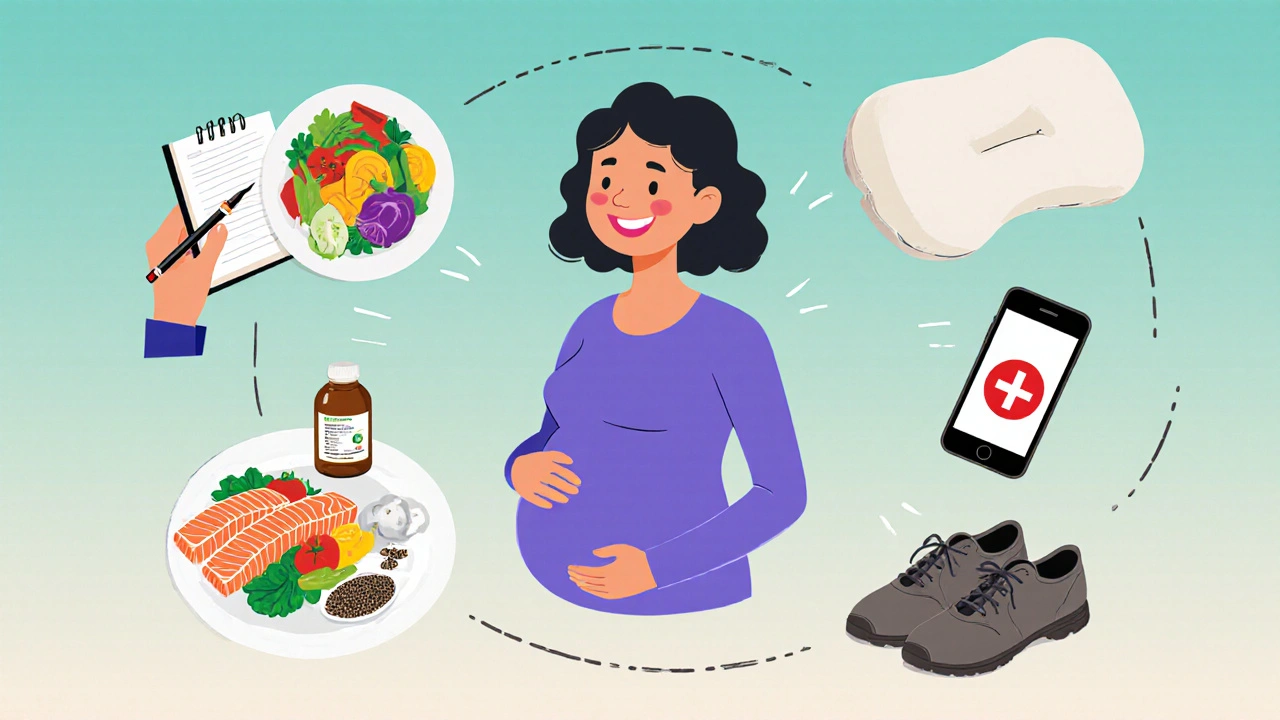Arthritis Medication Safety Checker
Check Medication Safety for Pregnancy
Select your trimester and medication type to see safety information.
Imagine waking up with sore joints, feeling the extra weight of a growing baby, and wondering whether the pain is just pregnancy or the flare‑up of a long‑standing condition. If you’re dealing with arthritis pregnancy, you’re not alone. Hundreds of women manage both at the same time, and the good news is that with the right knowledge you can keep both you and your baby healthy.
What Happens to Arthritis When You’re Expecting?
Arthritis is a chronic condition that causes joint inflammation and pain. Pregnancy introduces a cocktail of hormones-most notably Estrogen and relaxin-that can actually soften ligaments and reduce inflammation. For some women, this means a surprising lull in symptoms during the second trimester. For others, especially those with autoimmune forms like Rheumatoid arthritis is an autoimmune disease that targets joint linings and can flare unpredictably., the hormonal shift can trigger a rebound flare in the third trimester or postpartum period.
Understanding the difference between Osteoarthritis is a degenerative joint disease caused by wear and tear and autoimmune arthritis helps you predict how your body might react. Osteoarthritis tends to improve with the extra cushion of amniotic fluid, while rheumatoid arthritis can be more volatile.
Symptoms to Watch For
- Joint swelling that feels warm to the touch.
- Stiffness, especially in the morning or after periods of inactivity.
- Increased fatigue that goes beyond normal pregnancy tiredness.
- Pain that worsens at night, potentially disturbing sleep.
If you notice any of these symptoms intensifying after the first trimester, it’s a cue to talk to your obstetrician and rheumatologist together.
Safe Medication Options During Pregnancy
Medication safety is the biggest concern for expectant mothers. Not all anti‑inflammatory drugs are created equal.
| Medication | Category | Pregnancy Safety (FDA) | Typical Use in Arthritis |
|---|---|---|---|
| Acetaminophen | Analgesic | Category B - Generally safe | Pain relief |
| Ibuprofen | NSAID | Category C - Avoid after 20 weeks | Inflammation control |
| Diclofenac | NSAID | Category C - Use only if benefits outweigh risks | Severe joint pain |
| Hydroxychloroquine | DMARD | Category C - Often continued in rheumatic disease | Long‑term disease control |
| Prednisone | Corticosteroid | Category C - Short courses are acceptable | Flare management |
When you see NSAIDs are non‑steroidal anti‑inflammatory drugs that reduce pain and swelling, remember they’re safest before the 20‑week mark. After that, they can affect fetal kidney development. DMARDs are disease‑modifying antirheumatic drugs that slow disease progression such as methotrexate are absolutely contraindicated, but some (hydroxychloroquine, sulfasalazine) may be continued under specialist guidance.

Non‑Pharmacologic Strategies That Really Work
Medication isn’t the only tool in your kit. Physical therapy, proper posture, and smart lifestyle tweaks can dramatically ease discomfort.
- Physical therapy involves guided exercises, manual techniques, and education to improve joint function. A therapist can teach you safe, low‑impact stretches that keep the joints mobile without over‑loading them.
- Water‑based workouts (prenatal yoga, aqua aerobics) support the body while taking pressure off aching knees and hips.
- Heat packs for 15‑minute intervals can loosen stiff joints; cold packs work well after a day of standing.
- Supporting shoes with arch stability and a cushioned insole reduce impact during daily walks.
- Using a pregnancy pillow to keep the spine aligned while sleeping reduces overnight swelling.
Nutrition, Supplements, and Fetal Health
What you eat influences inflammation levels. Aim for an anti‑inflammatory diet rich in omega‑3 fatty acids (salmon, chia seeds), colorful vegetables, and lean protein.
Prenatal vitamins, especially those with adequate vitamin D and calcium, support bone health for both mother and baby. If you’re low on omega‑3s, a physician‑approved fish‑oil supplement can be beneficial-but always check the purity and mercury content.
Regular Monitoring: Keeping the Doctor in the Loop
Joint health isn’t a solo mission during pregnancy. Schedule joint‑specific check‑ups every 4-6 weeks, and coordinate them with your obstetric appointments. Blood tests that measure inflammatory markers (CRP, ESR) help your rheumatologist gauge disease activity without relying solely on symptoms.
Fetal ultrasounds at the standard 20‑week and 32‑week marks are routine, but let your provider know if you’re on any medication that could affect fetal growth. Most of the drugs listed in the table above have well‑documented safety profiles, yet each pregnancy is unique.

Red Flags: When to Seek Immediate Care
- Sudden, severe swelling of a joint accompanied by fever-could signal septic arthritis.
- Sharp, unexplained abdominal pain combined with joint pain-might indicate a complication like pre‑eclampsia.
- Persistent high blood pressure or protein in urine alongside worsening arthritis symptoms.
If any of these emerge, call your obstetrician right away or head to the emergency department.
Quick Checklist for Managing Arthritis While Expecting
- Talk to both your rheumatologist and obstetrician early-ideally before conception.
- Keep a symptom diary: note joint pain, swelling, medication doses, and diet.
- Stick to safe meds listed in the table; avoid over‑the‑counter NSAIDs after week 20.
- Schedule regular physical‑therapy sessions focused on low‑impact movement.
- Eat an anti‑inflammatory diet; supplement with prenatal vitamins and approved omega‑3s.
- Monitor blood pressure and urine protein at each prenatal visit.
- Know the red‑flag symptoms and have a plan for emergency care.
Frequently Asked Questions
Can rheumatoid arthritis flare during pregnancy?
Yes. While many women experience reduced symptoms in the second trimester, about 30 % report flares in the third trimester or postpartum. Hormonal changes, stress, and medication adjustments all play a role.
Are NSAIDs completely off‑limits after 20 weeks?
They’re not “completely” off‑limits, but they’re classified as Category C after week 20, meaning the potential risk to the fetus outweighs the benefit in most cases. Ibuprofen, naproxen, and similar drugs should be avoided unless a doctor deems them essential.
Is it safe to continue hydroxychloroquine throughout pregnancy?
Hydroxychloroquine is a Category C drug, but numerous studies show it does not increase birth defects and can help keep rheumatoid arthritis under control. Most rheumatologists recommend continuing it if you were already stable on the medication.
What exercises are safest for sore joints?
Low‑impact activities like prenatal yoga, swimming, and stationary cycling keep joints moving without added pressure. A physical therapist can tailor a program that respects your trimester and specific joint concerns.
Should I stop all arthritis medication once I’m pregnant?
No. Abruptly stopping medication can cause severe flares that harm both you and the baby. Instead, work with your providers to switch to pregnancy‑compatible drugs and adjust dosages as needed.


Comments
Benedict Posadas
Hey ladies and gents, congrats on the bump and the joint hustle! 🌟 Remember, staying active is key – even a short walk around the block can keep those joints lubricated and mood up. Try swapping those heels for supportive sneakers – your knees will thank you. And don’t forget to hydrate; water helps flush out inflammatory by‑products. If you feel a flare, a warm compress for 15 minutes can soothe the ache, then follow with a gentle stretch. Keep a symptom diary – jotting down pain levels, meds, and meals helps you and your doc spot patterns fast. Most of all, trust your body; pregnancy can be a magical time of change, and many find a surprising lull in arthritis symptoms during the second trimester. Keep smiling and keep moving! :)
October 22, 2025 at 19:16
Michael Vandiver
Love this info 🙌! I always say stay active, stay safe, and when in doubt, ask your doc. 🎉 Hydration + comfy shoes = happy joints. Remember NSAIDs after week 20 are a no‑go unless absolutely needed. Keep that diary handy and share it at every appointment.
October 23, 2025 at 02:12
Harini Prakash
Thanks for the thorough guide 😊. It’s so reassuring to know that gentle water‑based exercises can make a big difference. I’ve found that prenatal yoga not only eases stiffness but also helps with breathing during flares. Keep using a pregnancy pillow at night – it really does keep the spine aligned and reduces swelling. Remember, balanced nutrition with omega‑3s can lower inflammation, so sprinkle some chia seeds into your smoothies. And always keep those check‑ups on schedule; early catching of a flare can save a lot of discomfort later. Stay positive and listen to your body! :)
October 23, 2025 at 09:09
Rachael Turner
It's fascinating how hormones can both calm and stir the immune system. In the second trimester many feel a lull, yet the third can bring a surprise flare. Think of your body as a tightly tuned orchestra – one instrument out of sync can affect the whole melody. Keeping a symptom journal is like keeping sheet music, it helps the doctors see the rhythm of your disease. Gentle stretches, heat therapy, and proper footwear are simple tools that can keep you playing smoothly. Remember that mental calmness can also tone down inflammation, so breathing exercises are worth a try.
October 23, 2025 at 16:06
Suryadevan Vasu
Avoid NSAIDs after the second trimester.
October 23, 2025 at 23:02
Vin Alls
First and foremost, congratulations on navigating two monumental journeys simultaneously – the miracle of gestation and the management of arthritis. You stand at the crossroads of biology and resilience, and there are several strategies you can weave into your daily tapestry. Start with a diet that reads like a painter’s palette: vibrant reds from tomatoes, deep greens from spinach, and the golden sheen of turmeric-infused soups. These foods are not merely colorful; they are brimming with antioxidants that can gently coax down systemic inflammation.
Next, consider the rhythm of movement. Low‑impact activities such as prenatal yoga, swimming, or a leisurely stroll with a supportive stroller can keep synovial fluid circulating without overburdening your joints. The key is consistency – a thirty‑minute session three times a week can be more beneficial than a marathon once a month.
When it comes to pharmacology, your arsenal should be curated with caution. Acetaminophen remains a stalwart ally in the analgesic realm, while NSAIDs like ibuprofen should retreat after week twenty due to fetal renal considerations. Hydroxychloroquine, often misunderstood, has a solid safety record in pregnancy and can be continued under specialist supervision. Prednisone, when employed in short bursts, can quell acute flares without imposing substantial risk.
Physical therapy is another cornerstone. A skilled therapist can design a regimen that respects your trimester’s biomechanical shifts, focusing on joint stabilization, gentle mobilization, and posture correction. Think of it as a bespoke suit, tailored to your evolving silhouette.
Sleep hygiene is often overlooked but is paramount. A well‑positioned pregnancy pillow can alleviate nocturnal swelling, while alternating heat and cold packs can modulate pain pathways for a more restorative night. Remember to keep your blood pressure and proteinuria under vigilant watch, as these parameters can signal broader obstetric concerns.
Lastly, empower yourself with knowledge and community. A symptom diary, like a captain’s log, provides invaluable data for both your rheumatologist and obstetrician, ensuring collaborative decision‑making. Online support groups can also offer the camaraderie that reminds you you are not navigating these waters alone.
In essence, blend nutrition, measured exercise, judicious medication, and vigilant monitoring into a harmonious regimen. Your body is capable of astonishing adaptation; with the right guidance, you can glide through pregnancy with both you and your baby thriving.
October 24, 2025 at 05:59
Bret Toadabush
Listen, the mainstream medical advice is just a cover‑up to keep us compliant. They say NSAIDs are dangerous after week 20, but have you ever considered that the pharmaceutical giants push these stories to sell more alternative drugs? Even the "safe" hydroxychloroquine is being whispered about because of hidden agendas. You gotta stay vigilant, read between the lines, and don’t let the government dictate what you can or cannot take for your own body. Protect your unborn child by questioning every recommendation and demanding full transparency – the truth is out there.
October 24, 2025 at 12:56
Iris Joy
Great rundown, especially the part about low‑impact workouts – they truly are a game‑changer. If you’re feeling hesitant about starting a new exercise routine, consider partnering with a prenatal physiotherapist who can customize movements to your comfort level. Also, don’t underestimate the power of a well‑balanced anti‑inflammatory diet; adding a spoonful of flaxseed oil to your morning smoothie can give you a steady omega‑3 boost. Keep tracking your symptoms; the diary will become your strongest ally when discussing options with your doctors. You’ve got a solid plan – stay consistent and trust the process.
October 24, 2025 at 19:52
WILLIS jotrin
Harini’s point about prenatal yoga resonated with me – it’s less about fitness and more about mindfulness. When the body’s hormones start playing tricks, grounding yourself through breath work can actually modulate the immune response. Think of each session as a meditation for your joints, allowing tension to melt away while you nurture the life inside. It’s a simple yet profound practice that aligns the mind‑body connection, which is crucial for managing any chronic condition during pregnancy.
October 25, 2025 at 02:49
Kiara Gerardino
While everyone is busy doling out “tips,” the real issue is that many of these guidelines are rooted in outdated research. It’s irresponsible to accept them without scrutiny. Physicians must be held accountable for prescribing only what is truly safe, not what the pharmaceutical lobby deems convenient. If we continue to follow these half‑hearted recommendations, we risk compromising both maternal and fetal health. Stand up, demand evidence‑based care, and reject the complacency that pervades our medical system.
October 25, 2025 at 09:46